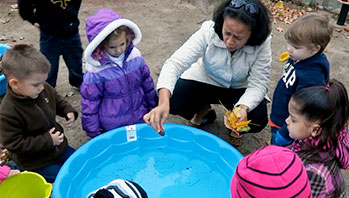- Between the Lions alphabet chart
- clipboard
- juice box
- markers
- paper
- alphabet
- communicate
- explore
- family
- letter
MA Standards:
Speaking and Listening/SL.PK.MA.1a: Observe and use appropriate ways of interacting in a group.
Foundational Skills/RF.PK.MA.1: With guidance and support, demonstrate understanding of the organization and basic features of printed and written text: books, words, letters, and the alphabet.
Writing/W.PK.MA.2: Use a combination of dictating and drawing to explain information about a topic.
Head Start Outcomes:
Social Emotional Development/Social Relationships 3: Develops friendships with peers.
Approaches to Learning/Cooperation 1: Plans, initiates, and completes learning activities with peers.
Approaches to Learning/Cooperation: Helps, shares, and cooperates in a group.
Literacy Knowledge/Alphabet Knowledge: Recognizes that the letters of the alphabet are a special category of visual graphics that can be individually named.
Literacy Knowledge/Print Concepts & Conventions: Recognizes print in everyday life, such as numbers, letters, one’s name, words, and familiar logos and signs.
Literacy Knowledge/Print Concepts & Conventions: Understands that print conveys meaning.
PreK Learning Guidelines:
English Language Arts/Language 5: Listen to and use formal and informal language.
English Language Arts/Reading and Literature 7: Develop familiarity with the forms of alphabet letters, awareness of print, and letter forms.
Explore Together (outdoors): Letter Hunt

© Commonwealth of Massachusetts, Department of Early Education and Care. All rights reserved.
Educator Prep: Print out the Between the Lions alphabet chart or create an alphabet chart on chart paper.
Display the alphabet chart. Ask children if they found any letters at home yesterday. Have them describe where they found the letters.
Introduce the concept that letters are used to make words. Look around the room and point out environmental print in signs, in books, on food labels, etc. Read the words and explain that words communicate or give information to people. Say, Usually when you see letters they are put together to make words that give people information.
- Hold up Chicka Chicka Boom Boom and ask children what information the words are giving them. (title of the book)
- Hold up <juice box> and read the words and ask what information are the words giving them. (type of juice) Ask children to give other examples.
Tell children that today they will go outside to explore places that have letters and words. Ask, Where do you think we can look to find letters outside? Have children dictate or write their responses on a clipboard to bring outside. Pair children or designate small groups so they can share ideas as they explore. As you bring children outside, sing “A Hunting We Will Go.” (letter version)
Once outside, engage children as they explore and talk about places they find letters and words. For example, say,
- Therese found letters on the school building. Ask, What information do you think the words on the school building are giving us? (name of school)
- Jacob found some letters on this street sign. Point and tell children that the letters make the word Stop. Ask, How can this information help a person who is driving a car? How can it help you if you are going to cross the street?
Reflect and Share Together
Once inside, discuss what children learned about letters. Ask children to draw a picture of one place they found letters outside. Allow time for them to share their drawings. Collect children’s pictures into a class book that you can leave on display in the Writing Center.
A-Hunting We Will Go (letter version)
A-hunting we will go,
A-hunting we will go,
We’re off to find some letters
Around the room we go!
Adaptation: For children already comfortable with the alphabet and letters, you may want to give them particular letters and have them find as many examples of that letter as they can. Or give them a string of letters.
Social Emotional Tip: Encourage children to talk about what it was like exploring with a friend. Discuss how exploring with a friend can help you notice things you may have missed or help you share your ideas to help someone else learn something.
